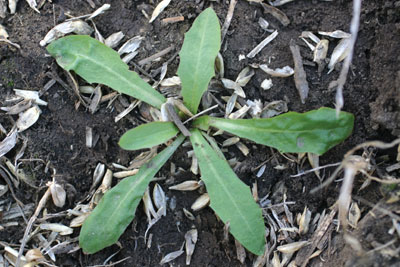
Features
Agronomy
Weeds
Narrow-leaved hawk’s-beard can hammer yield
Something has been sneaking up on John Kotylak for 15 years, ever since he parked his tillage equipment for the last time. It is one very bad weed: narrow-leaved hawk’s-beard (NLHB).
May 1, 2009 By Editorial Staff
Something has been sneaking up on John Kotylak for 15 years, ever since he parked his tillage equipment for the last time. It is one very bad weed: narrow-leaved hawk’s-beard (NLHB). “If it’s in a field and it’s bad then you can count on losing a third of your yield or in really bad places up to a half,” says Kotylak. He would know, since it is only him, his brother and his 80-year-old grandfather glancing over at the yield monitor screen while they combine their 8000 acres around Balcarres, Saskatchewan or poring over yield maps in the office in the off-season.
 |
| Early field scouting can help identify narrow-leaved hawk’s-beard before it can affect growth and ultimately yield. Photo courtesy of DuPont Canada |
Sometimes in the summer, when he has the Autosteer engaged in the tractor cab along one particularly long swath, he unhooks his BlackBerry from his belt and scrolls through the latest messages from local retailers and crop protection companies. “It makes me laugh,” he says. “Narrow-leaved hawk’s-beard usually isn’t mentioned by most of the companies but for us it’s the weed that’s causing the most stress out of anything.”
Kotylak is not alone. According to Stratus Market Research, growers sprayed more than 2.7 million acres for NLHB in 2007. That is almost three times as many acres as in 2005.
Narrow-leaved hawk’s-beard is an annual or a winter annual weed. And it is a prolific seed producer; each plant can produce 3000 to 50,000 seeds. It is now becoming a problem in areas where it has never been seen before, even in southwestern Saskatchewan and the dryer parts of the Brown Soil Zone. “We started to notice it 12 to 15 years ago,” says Kotylak. “We’ve been direct seeding since the early nineties. We’d spray durum in August and the thistles would die, the willows would die, the grasses would die but when it got wet, the narrow-leaved hawk’s-beard seed would germinate and would be there in the spring.”
NLHB annuals emerge from mid-May to mid-June and NLHB winter annuals emerge from early August to mid September. In the rosette stage, the weed looks a lot like dandelion. Fully grown it resembles a sow thistle with its yellow flowers.
For growers scouting their fields early enough to spot NLHB in the cotyledon stage, the weed can be identified by its oval shape with short stalks. The early leaves have prominent stalks and often have a few distinct teeth on the margins of the leaves that point back toward the centre of the plant. One way to tell a very young NLHB plant from stinkweed is by breaking a leaf, which will cause it to ooze a milky substance.
Before the widespread adoption of no-till farming technology, the weed was mainly controlled with fall or spring tillage. This is still a good control mechanism, however plants can easily re-root after tillage, especially in wet conditions. Often, herbicide treatments are more effective. “It’s an easy enough plant to kill by tillage but we don’t want to do that,” says Kotylak. Now he adds Express SG to his annual glyphosate burn-off in the spring. “The only thing that seemed to work was Express.”
Like most weeds, NLHB is easiest to control when it is small, with the best control prior to the four-leaf stage. The longer the plant grows, the more it will deplete soil nutrients and moisture reserves. A pre-harvest herbicide application can get annual weeds when they are small and a post-harvest application will take care of the winter annuals.
Kotylak leaves his canola as the last crop to harvest. Sometimes that means he cannot get on the ground with the sprayer before the snow flies in October. That is why he relies on Express SG tank-mixed with glyphosate in the spring as a pre-seed burn-off to control tough weeds like narrow-leaved hawk’s-beard. Growers also use Express to heat up control of dandelion, flixweed, stinkweed, wild buckwheat and volunteer canola, including Roundup Ready canola.
For a post-emergent application to control NLHB, products from the Refine, Triton or Harmony lines from DuPont all work well. Prior to bolting is usually the ideal time. Past that stage, NLHB is tougher to control. “Over the past few years a lot of producers have tank-mixed Achieve with Buctril M or Buctril M with Horizon but they don’t control it,” says Cal McGuckin of the Viterra Crop Production Centre in Delia, Alberta. “This year we used Harmony K for NLHB and for buckwheat and dandelion. We sold quite a bit with not one complaint.”
“We recommend a burn-off with Express SG or Express PRO plus glyphosate as the first choice for NLHB control,” says Jon Gough, cereal herbicides product manager for DuPont. “Following up with an in-crop treatment of Refine SG works really well, especially if you have wild buckwheat up to the 5-leaf stage, hemp-nettle, chickweed, Russian thistle or cow cockle.”
Gough says that DuPont offers other products, such as Refine M, Triton C, Triton K, Harmony SG and Harmony K for control of NLHB. In addition, each product controls a broad range of other key weeds. The company suggests growers check www.weedwreckingcrew.com for a list of the best products for their crop and weed spectrum.